Outlined in the field tincture


Alfonso IX of Leon
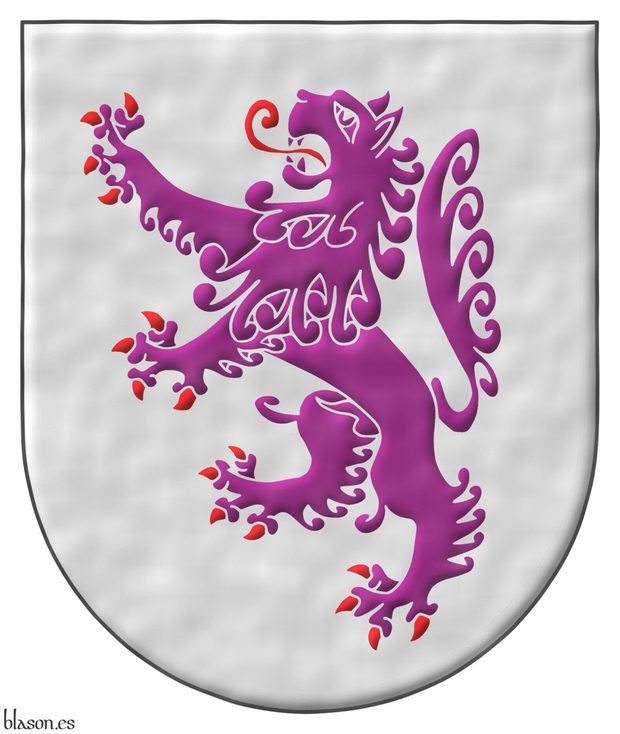
Born on August 15, 1171, in Zamora and died on September 24, 1230, in Sarria, Lugo.
Argent, a lion rampant Purpure, armed and langued Gules.
Escudo de plata, un león rampante de púrpura, armado y lampasado de gules.
Arms of the king of León interpreted by me as follows: the escutcheon is in a semi-circular arch; the field and the lion have been enameled and illuminated; and the ensemble has a watercolor finish.
This coat of arms of León can be seen, among many other places, for example, in [Argote de Molina, G.; 1588; chapter XLII].
Blazon keywords: Without divisions, Argent, Purpure, Gules, One, Lion, Rampant, Armed and Langued.
Style keywords: Semi-circular, Illuminated, Outlined in the field tincture and Watercolor.
Classification: Interpreted, Personal, Coat of arms and Kingdom of León.
Bearer: Alfonso IX of Leon.


Bartolomé Quesada Valles

Sable, semé of Tulips Or; on a chief cousu Azure, two Crowns Or, in fess.
Escudo de sable, sembrado de tulipanes de oro; el jefe cosido de azur, dos coronas de oro, en faja.
Blazon keywords: Without divisions, Sable, Or, Azure, Chief, Two, Crown, In fess, Semé and Tulip.
Style keywords: Soft metal, Semi-circular, Illuminated, Outlined in the field tincture, Outlined in sable and Cousu.
Classification: Coat of arms, Created and Personal.
Bearer: Quesada Valles, Bartolomé.


Baudry in France
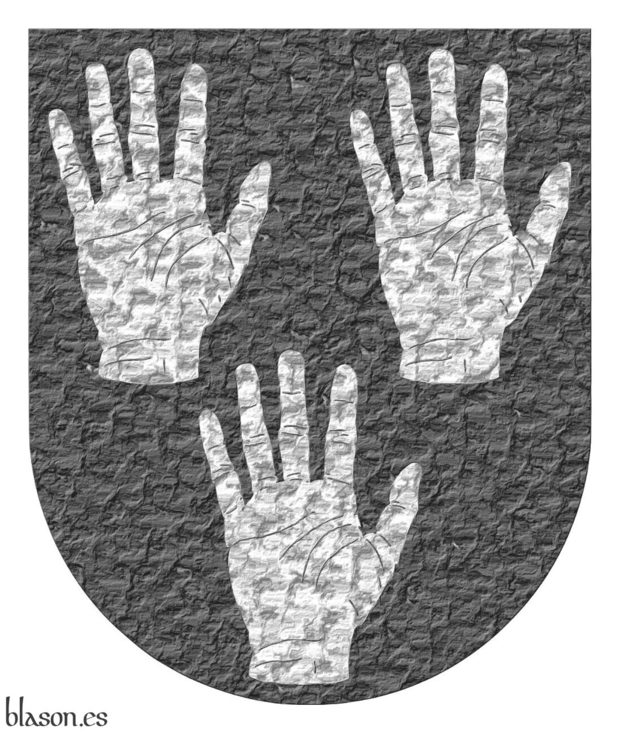
Sable, three dexter hands turned up, and appaumée Argent.
Escudo de sable, tres manos diestras levantadas y apalpadas de plata.
Coat of arms interpreted based on blazon and explanations of [Avilés, J.; 1725a; pages 34 y 35 y sheet 2 figure 38].
Blazon keywords: Without divisions, Sable, Three, Hand, Dexter, Argent, Turned up, Appaumée and Ordered.
Style keywords: Semi-circular, Plain tincture, Outlined in the field tincture and Soft metal.
Classification: Interpreted, Personal and Kingdom of France.
Bearer: Baudry en Francia.


Ferdinand II, imaginary coat of arms

Argent, a lion sejant erect Purpure.
Escudo de plata, un león sentado de púrpura.
Imaginary coat of arms of King Fernando II of León, which I have developed based on his seal and the arms of his successor, with: the shape of the coat of arms is semi-circular; the field enameled in flat argent; the lion enameled in purpure and illuminated; and the whole rendered with a watercolor finish.
For this imaginary coat of arms I have chosen a representation of the lion in a posture similar to that of the great seal appearing in [Fernando II de León; 1167], which is sejant ~ «sentado» in Castilian, although beginning to rise «sejant erect».
It should be noted that we are in a pre-heraldic period where the possible attitudes of the lion were not yet clearly defined, although several of them are already anticipated in the great seals of Fernando II, as can be seen, for example, passant in [Fernando II de León; 1181] and in other attitudes in the photographs of [Martín Fuertes, J. A.; 2002].
Blazon keywords: Without divisions, Argent, Lion, Purpure and Sejant.
Style keywords: Semi-circular, Illuminated, Outlined in the field tincture and Watercolor.
Classification: Interpreted, Imaginary, Coat of arms and Kingdom of León.
Imaginary bearer: Ferdinand II of Leon.


Geoffrey Plantagenet
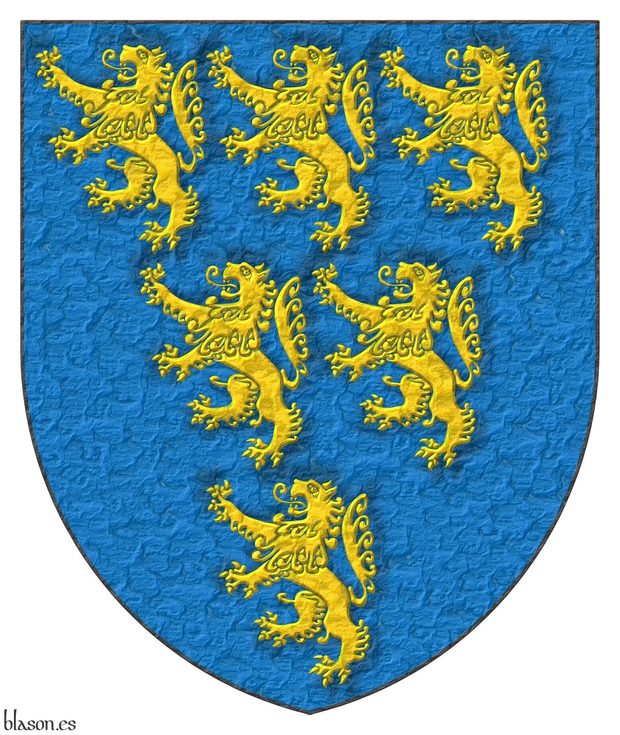
Azure, six lions rampant Or, 3, 2 and 1.
Escudo de azur, seis leones rampantes de oro, 3, 2 y 1.
Existing armories interpreted by me as follows: the shape of the shield is pointed; the field has been enameled in flat azure; the 6 lions are illuminated and cast shadows on the field; and the entire composition has a hammered metal finish.
The shield of Geoffrey V, Count of Anjou is considered the first documented coat of arms in history, dated to 1127, when Henry I of England gifted it to him on the occasion of his marriage to his daughter Matilda of England [The Heraldry Society; 2013].
There is no direct evidence that Henry I possessed a coat of arms, nor that it featured a rampant lion [Humphery-Smith, C.; 1983], but the gift of a shield with 6 lions to his future son-in-law could be an indication of such.
Geoffrey is buried in the Cathedral of Saint Julian in Le Mans, and his tomb is decorated with an enamel depicting him with his shield, where of his 6 lions: 4 are fully visible, and 2 are suggested by their claws.
However, it is possible that both the wedding gift narrative and the enamel on the tomb are from years after his death in 1151, so [Pastoureau, M.; Garvie, F.; 1997; page 18] asserts that «this account was written after Geoffrey's death... and his funerary enamel commissioned by his widow Matilda between 1155 and 1160... therefore it is possible that Geoffrey Plantagenet never had a coat of arms».
Blazon keywords: Without divisions, Azure, Six, Lion, Or, Rampant and Three, two and one.
Style keywords: Pointed, Illuminated, Shaded, Outlined in the field tincture and Metal beaten.
Classification: Interpreted, Personal, Coat of arms and House of Plantagenet.
Bearer: Godfrey V, Count of Anjou.


Holy Trinity
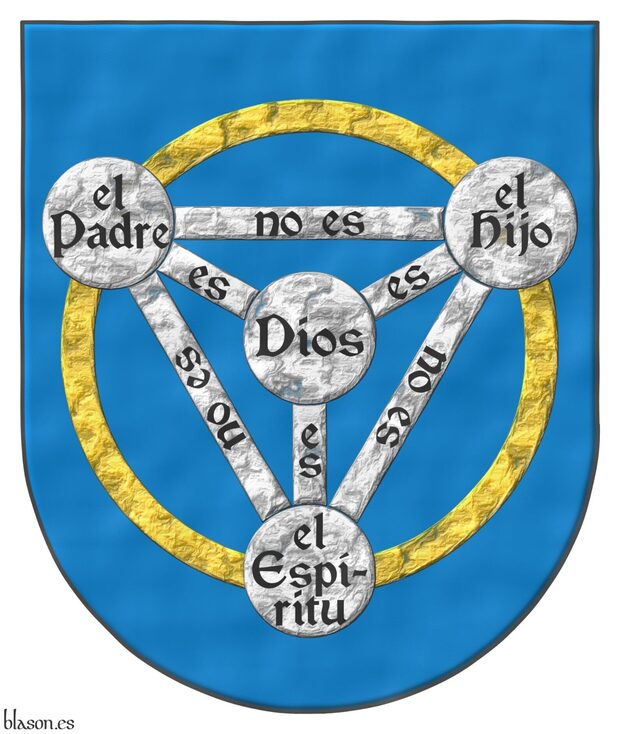
Azure, a pall couped Argent, its three arms charged with «es» Sable, within a triangle reversed Argent, its three arms charged with «no es» Sable, within an annulet Or, all debruised by four plates, three on the vertex of the triangle, in dexter chief, charged with «el Padre» Sable, in sinister chief, charged with «el Hijo» Sable, in base, charged with «el Espítiru» Sable, and one on the fess point, charged with «Dios» Sable.
Escudo de azur, una perla recortada de plata, sus tres brazos cargados con «es» de sable, dentro de un triángulo ranversado de plata, sus tres brazos cargados con «no es» de sable, dentro de un anillo de oro, todo resaltado de cuatro bezantes de plata, tres sobre los vértices del triángulo, en la diestra del jefe, cargado de «el Padre» de sable, en la siniestra del jefe, cargado con «el Hijo» de sable, en la punta, cargado con «el Espítiru» de sable y uno sobre el corazón, cargado con «Dios» de sable.
Imaginary coat of arms that I have interpreted as follows: its base is semicircular (round); its field is illuminated in watercolor Azure; the rest in heavily beaten metal, outlined of the field and illuminated in Argent, except for the annulet which is illuminated in Or; and its letters all in plain Gules ink.
Annulet
The circular crown when it is large and in the middle of the shield [Cadenas y Vicent, V. de; 1975] is called an annulet. [Avilés, J.; 1780a; pages 296 and 297] calls it annulet or small annulet depending on its size, if it is large an annulet and if it is small a small annulet. In English and French heraldry it is called «cyclamor» and hence the expression «cyclamor annulet» can also be found.
This annulet is my aesthetic contribution to this imaginary coat of arms as it is normally not represented with this annulet.
Bordure and Orle
In other interpretations the words «non est» go on a bordure or on an orle, the latter being the case blazoned, for example, [Husenbeth, F. C.; 1882; 2nd appendix] in the following way: «Gules, an orle and pall Argent, conjoined and surmounted of four plates, occupying the dexter and sinister chief and the base and fess points respectively; the first inscribed Pater, the second Filius, and the third Spiritus Sanctus, the centre Deus; the connecting portions of the orle between them having the words non est, and those of the pall est».
Blazon keywords: Without divisions, Azure, Cyclamor, Pall, Cerrado, Argent, Charged, Bezant and plate, Or, Dexter, Sinister, Chief, Base (lower 1/3) and Heart.
Style keywords: Semi-circular, Illuminated, Outlined in the field tincture, Watercolor and Hard metal.
Classification: Religious, Interpreted, Imaginary and Coat of arms.
Imaginary bearer: Holy Trinity.


Hufflepuff House with 2 badgers
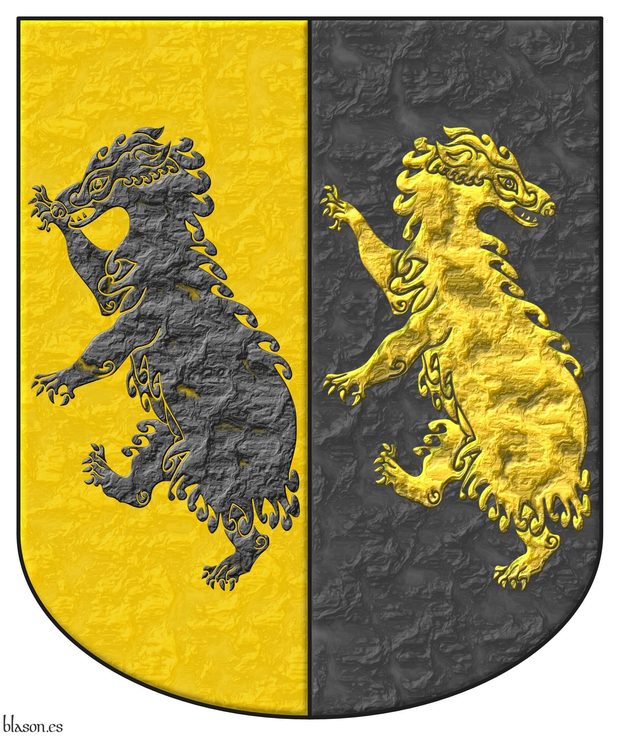
You might belong in Hufflepuff where they are just and loyal. In Hufflepuff they are very patient and unafraid of hard work.
Party per pale: 1 Or, a badger rampant Sable; 2 Sable, a badger rampant, regardant Or.
Escudo partido: 1o de oro, un tejón rampante de sable; 2o de sable, un tejón rampante, contornado de oro.
Imaginary arms of Hufflepuff realized in the following way: the mouth of the coat of arms is rounded; the field is illuminated and has a marble finish; and the badgers, each facing one side, are illuminated, outlined by the field, and finished with a hammered metal effect.
The initial quote, next to the Hufflepuff coat of arms, is taken from [Rowling, J. K.; 1997] and corresponds to «You might belong in Hufflepuff, Where they are just and loyal, Those patient Hufflepuffs are true, And unafraid of toil».
When blazoning the 2nd badger, it must be taken into account that its head is regardant, which is what «is said of animals, or their heads, turned toward the sinister side of the shield» [Avilés, J.; 1725a; page 55] and [Avilés, J.; 1780a; page 61].
Blazon keywords: Party per pale, Or, Sable, Badger, Rampant and Regardant.
Style keywords: Rounded, Illuminated, Outlined in the field tincture, Marmoreal and Metal beaten.
Classification: Interpreted, Imaginary, Coat of arms and Harry Potter saga.
Imaginary bearer: Hufflepuff at Hogwarts.


Laird Sky
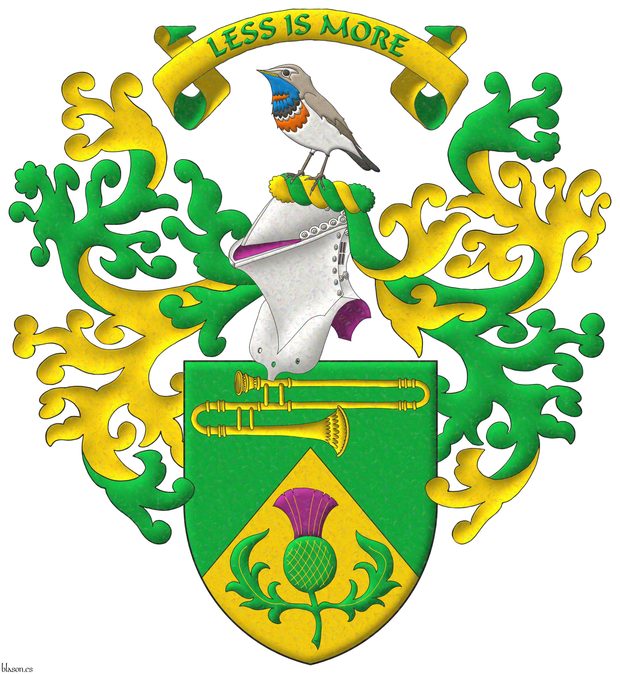
Party per chevron Vert and Or, in chief a sackbut fesswise Or, in base a thistle slipped and leaved proper. Crest: Upon a helm, with a wreath Or and Vert, a bluethroat (Luscinia svecica) proper. Mantling: Vert doubled Or. Motto above the crest: «Less Is More».
Illuminated, an irisdiscent finishing, and the inner of the thistle is outlined in the metal Or of its field.
Blazon keywords: Vert, Party per chevron, Or, In chief, Sackbut, Fesswise, In base, Thistle, Leaved, Slipped, Proper, Motto, Crest and mantling, Helm, Mantling, Wreath and Crest.
Style keywords: Iridescent (nacar), Outlined in sable, Outlined in the field tincture, Illuminated and Pointed.
Classification: Personal, Interpreted, Grant of arms, Heraldic document and Coat of arms.
Bearer: Sky, Laird.


Lineage Peraza of Cantabria, structured and parallel blazons
Ancient arms of the lineage Peraza of Cantabria emblazoned by me, with the blazon written in English and Castilian in a structured way to observe the parallelism between both forms.
Blazon keywords: Or, Vert, Sable, Holm oak, Eradicated, Fructed, In front (tree), Trunk, Boar, Passant and In pale.
Style keywords: Outlined in the field tincture, Illuminated, Semi-circular and Freehand.
Classification: Personal, Lineage, Interpreted, Structured and parallel blazons, Boa and Coat of arms.
Bearer: Peraza of Cantabria, lineage.


![Ver [Norsk Heraldisk Forening] en instituciones citadas. Fortaleza de oro y mazonada de sable.](../css/Fortaleza.Institucion.png)
Norsk Heraldisk Forening
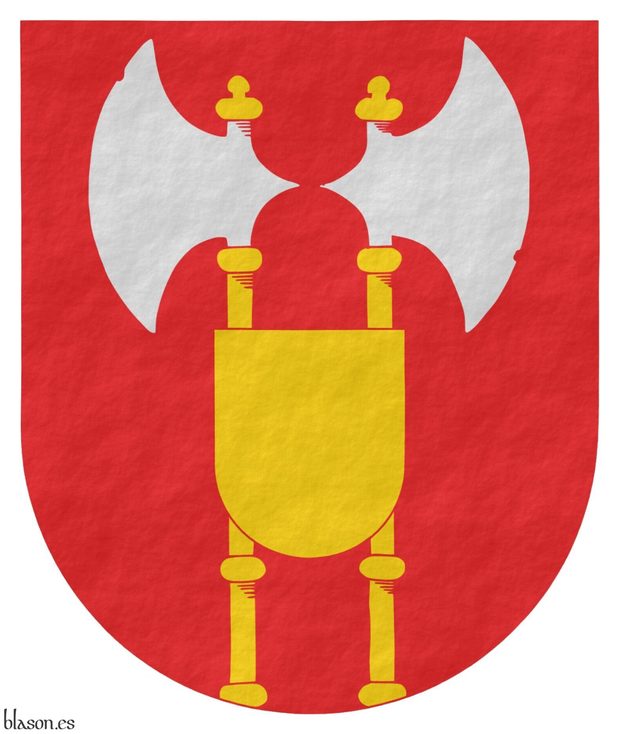
Norsk Heraldisk Forening, in English, Nordic Heraldry Society, was founded on February 27, 1969, at the National Archives in Oslo, with the aim of promoting the study and knowledge of heraldry through meetings, lectures, excursions, and other dissemination methods, and additionally, to become an advisory body to resolve issues in matters of heraldry, flags, personal coats of arms, etc. Its first president was Dr. Philos Herman L. Løvenskiold.
Since then, these have remained the objectives of the Norsk Heraldisk Forening, and its membership count has remained between 150 and 200 members, and it cooperates with the Nordic Heraldry Society, «Societas Heraldica Scandinavica».
The website's address is Heraldikk.no, its content is available in both Norwegian and English, and they work systematically to expand it and provide greater and better information to both its members and those interested in heraldry.
Blazon
Alex Maxwell Findlater described it in English, including its crest, in an article that was on their previous website under the title «About the society», as follows: «Gules issuant from base two battle-axes addorsed Argent shafted Or overall at the nombril point an escutcheon Or; for Crest between two axes of the arms a panache of three peacock feathers proper; Mantling Gules doubled Or». But given that «shafted» applies to weapons with a shaft and «hafted» to weapons with a handle, in the case of axes, I use «hafted» although both terms correspond to the Spanish «fustado».
Note how the axes are described as battle-axes, just as in the blazon of the Norwegian coat of arms, where its lion holds a battle-axe.
Coat of arms I attempted to interpret in the Norwegian style, all in flat tinctures, without Sable outlines, lighting or shading, and only with a simple rough finish.
Categories: Institution, Interpreted, Socioeconomic, Semi-circular, Plain tincture, Outlined in the field tincture, Rough, Coat of arms, Without divisions, Gules, Axe, Argent, Hafted, Or, Addorsed, Issuant from base, Overall, At the nombril and Escutcheon.


Pendón con inescutcheon de Edward IV

Banner quarterly of sixteen: 1, 6, 11, and 16 Azure, three fleurs de lis Or; 2, 5, 12, and 15 Gules, three lions, passant, guardant, in pale Or, armed and langued Azure; 3, 8, 9, and 14 Gules, a castle triple towered Or, port and windows Azure, masoned Sable; 4, 7, 10, and 13 Argent, a lion rampant Purpure, armed and langued Gules, crowned Or; an inescutcheon Azure, three crowns in bend, bendwise Or.
Pendón cuartelado de dieciseis: 1o, 6o, 11o y 16o de azur, tres flores de lis de oro; 2o, 5o, 12o y 15o de gules, tres leopardos en palo de oro, armados y lampasados de azur; 3o, 8o, 9o y 14o de gules, un castillo de oro, aclarado de azur, mazonado de sable; 4o, 7o, 10o y 13o de plata, un león rampante de púrpura, armado y lampasado de gules, coronado de oro; un escuson de azur, tres coronas en banda, puestas en banda de oro.
Banner interpreted as follows: with the 5x6 proportions of a shield; the field, including that of the escutcheon, is enamelled with flat tinctures Gules and Azure; the crowns, castles, fleurs-de-lis, and leopards are outlined in Sable; except the lions, which are outlined in their field; and the whole composition is watercoloured.
In the armorial [Edward IV of England; 1461; row 27, 1st column, final banner], these arms appear twice:
- At the beginning, in the equestrian portrait of Edward IV, on the caparison of his horse.
- In the final banner held by Edward IV’s personal badge, a «White Lion of March».
Blazon keywords: Quarterly, Azure, Or, Three, Fleur de lis, Ordered, Gules, Leopard, Armed, Langued, In pale, Sable, One, Castle, Port and windows, Masoned, Argent, Purpure, Lion, Rampant, Crowned, Inescutcheon, Crown, In bend and Bendwise.
Style keywords: Rectangular, Illuminated, Outlined in sable, Outlined in the field tincture and Watercolor.
Classification: Interpreted, Personal, Flag, Banner of arms, Kingdom of England and House of York.
Bearer: Edward IV of England.


Qasqante of Navarre

Of the twelve lineages of Noblemen, the tenth is that of Qasqante; they bear as arms a shield Or and, on the shield, an eagle Sable, which is black, as it is now painted.
Or, an Eagle displayed Sable.
Escudo de oro, un águila de sable.
Coat of arms interpreted with: a semicircular (round) base; the field in flat Or; the eagle outlined in the colour of the field and illuminated in Sable; and finished in highly-hammered metal.
Based on the tenth coat of arms of the Navarrese «ricoshombres» from [Bosque, J. del; 1540; folio 1 of the numbering of 1613] and the text is from the transcription made by [Martinena Ruiz, J. J.; 1982; pages 122 and 123].
Under the title «Surname of Cascante» it can also be consulted in [Vega, P. J. de; 1702; folio 10 of the manuscript].
Blazon keywords: Without divisions, Or, Eagle and Sable.
Style keywords: Semi-circular, Illuminated, Outlined in the field tincture and Hard metal.
Classification: Interpreted, Personal and Kingdom of Navarre.
Bearer: Qasqante of Navarre.


![Ver [Registro Internacional de Armas Gentilicias] en instituciones citadas. Fortaleza de oro y mazonada de sable.](../css/Fortaleza.Institucion.png)
Registro Internacional de Armas Gentilicias
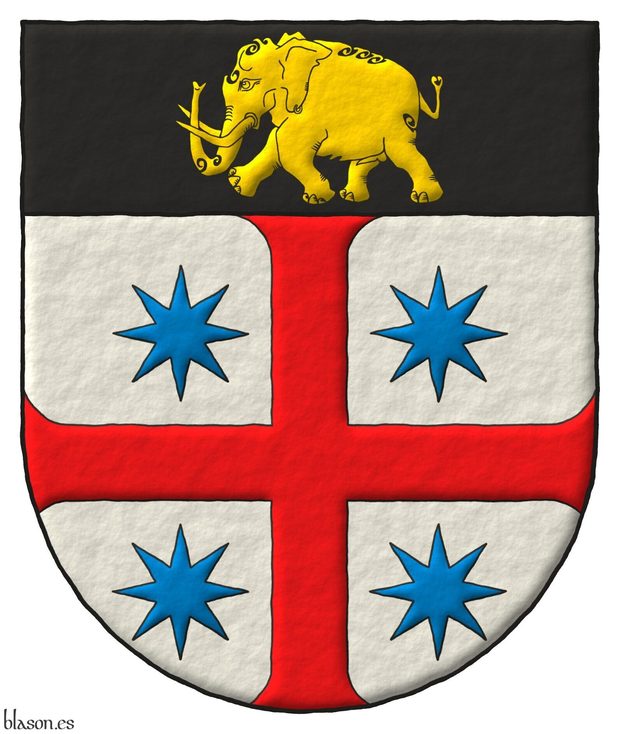
RIAG
Argent, a cross patty Gules, cantoned of four mullets of eight points Azure; on a chief Sable, an elephant passant Or.
The Registro Internacional de Armas Gentilicias, is also known as RIAG, and riag.com.es is it domain.
It is a private register of coat of arms founded in 2006 in Seville, Spain by the herald Ignacio Koblischek Zaragoza.
Categories: Institution, Socioeconomic, Semi-circular, Illuminated, Outlined in sable, Outlined in the field tincture, Freehand, Argent, Diminished cross, Patty, Gules, Cantoned, Mullet, Eight, Azure, Chief, Sable, Elephant, Passant and Or.


Spanish Night, tartan, design rationale

Dyes
This tartan has more black and yellow because these are the color Sable-black and metal Or-yellow of my coat of arms. Also, it has the other two colors Gules-red and Azure-blue, and one metal Argent-grey of my crest.
Structure
Over the black background, its main visual structure is a thin red line, a thick yellow line, and a thin red line because of the flag of Spain.
It is mostly symmetrical tartan because I am a heraldic artist and I love the symmetry and geometry. But there is a bit of asymmetry, two thin lines grey and blue, to break the uniformity.
Thread count
It is based in the 5 first terms (1, 2, 3, 5, 8) of the Fibonacci sequence (1, 1, 2, 3, 5, 8, 13, 21, 34...). This sequence is intimately connected with the golden ratio, 1.61803... that I use frequently in my designs. But for the thread count, I multiple the Fibonacci sequence by 6 to obtain more than 5 inches, then I use the numbers 6=(1x6), 12=(2x6), 18=(3x6), 30=(5x6), and 48=(8x6).
Blazon keywords: Quarterly, Or, Sable, One, Letter, Two, Wolf, Passant, In pale and Number.
Style keywords: Semi-circular, Illuminated, Outlined in the field tincture and Freehand.
Classification: Tartan, Created and Personal.
Bearer: Salmerón Cabañas, Antonio.


The coat of arms of The Honourable Society of Lincoln's Inn in 3 steps
Azure semé of millrinds Or; on a dexter canton Or, a lion rampant Purpure, armed and langued Gules.
Coat of arms of The Honourable Society of Lincoln's Inn emblazoned by me in 3 steps: initial geometric scheme, colors and metals, and lights and shadows.
Blazon keywords: Azure, Semé, Millrind, Or, One, Canton, Dexter, Lion, Rampant, Purpure, Armed, Langued and Gules.
Style keywords: Pointed, Outlined in sable, Outlined in the field tincture, Plain tincture, Illuminated and Freehand.
Classification: Socioeconomic, Interpreted, Coat of arms and Schema.
Bearer: Lincoln's Inn, The Honourable Society of.


UNAV
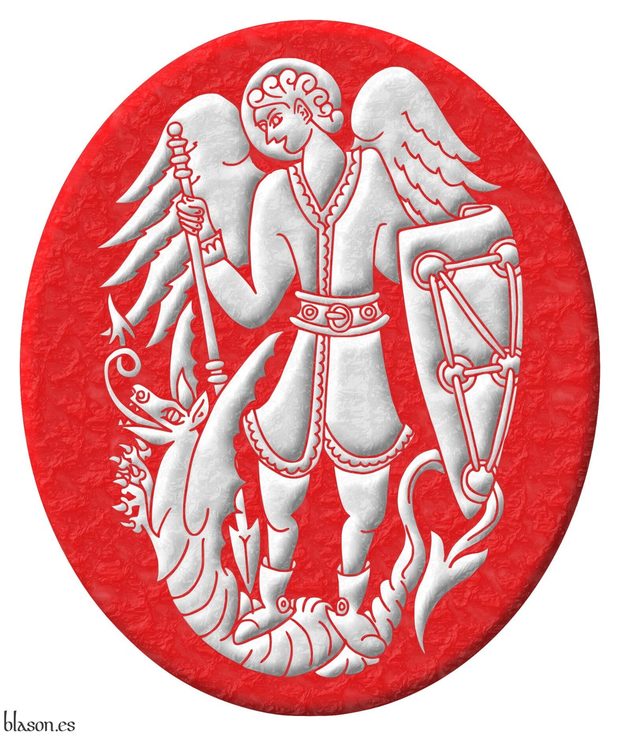
Emblem Azure, Saint Michael, grasping in his dexter hand a spear, point downward, and in his sinister hand bearing a coat of arms, upon a dragon Argent.
Emblema de azur, un Arcángel Miguel, teniendo en su diestra una lanza, con la punta hacia abajo y en su siniestra un escudo, sostenido por un dragón, todo de plata.
Two tinctures emblem interpreted as follows: an oval shape with a 5x6 proportion; the field illuminated in Gules, unlike its original colour; all its charges illuminated in Argent and outlined in the colour of the field; and the finish is marble-like.
The IESE Business School, where I studied, is the business school of the University of Navarre.
I also have the honour of having collaborated for years with the University of Navarre.
Blazon keywords: Without divisions, Gules, Male figure, Angel, Archangel, Argent, Grasping, Dexter, Spear, Point downwards, Sinister, Upon and Dragon.
Style keywords: Oval, Illuminated, Outlined in the field tincture and Marmoreal.
Classification: Interpreted, Socioeconomic, Education, Emblem and Kingdom of Navarre.
Bearer: University of Navarra.


Urban IV

182nd Pope of the Church, from 1261 to 1264. «Urbanus IV», born Jacques Pantaleon of Court-Palais, was born in Troyes, France.
Quarterly: 1 and 4 Azure, a fleur de lis Or; 2 and 3 Argent, a rose Gules.
Escudo cuartelado: 1o y 4o de azur, una flor de lis de oro; 2o y 3o de plata, una rosa de gules.
Coat of arms of Urban IV with: a pointed and rounded shield shape; the field in plain Azure and Argent enamels; the figures outlined in the field, shaded and illuminated in Or and Gules; and with a watercolor finish.
Blazon keywords: Quarterly, Azure, One, Fleur de lis, Or, Argent, Rose and Gules.
Style keywords: Ogee, Illuminated, Shaded, Outlined in the field tincture and Watercolor.
Classification: Interpreted, Religious and Papal States.
Bearer: Urban IV.


Urban VI

202nd Pope of the Church, from 1378 to 1389. «Urbanus VI», named Bartolomeo Prignano, born in Itri, near Naples, in the Lazio region.
Or, an eagle displayed Azure.
Escudo de oro, un águila de azur.
Papal coat of arms interpreted with: a pointed mouth; the field in flat tincture of metal Or; the eagle illuminated in Azure, shaded and outlined in the color of the field; and the whole with a rough finish.
Blazon keywords: Without divisions, Or, One, Eagle and Azure.
Style keywords: Pointed, Illuminated, Outlined in the field tincture, Shaded and Rough.
Classification: Interpreted, Religious and Papal States.
Bearer: Urban VI.


Val'Quirico over Chinapieria
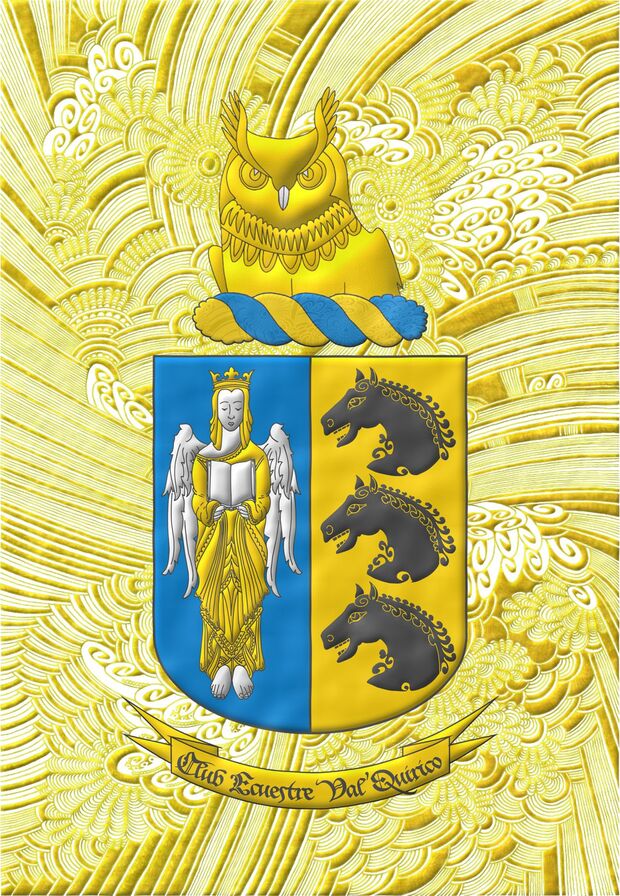
Party per pale: 1 Azure, an angel Argent, crowned, crined and vested Or holding an open book Argent; 2 Or, three horses' heads couped, in pale Sable. Crest: Upon a wreath Or and Azur, an owl's head couped at the shoulders Or, beaked Argent. Motto «Club Ecuestre Val’Quirico».
Watercolor finish over a Chinapieria Or.
Blazon keywords: Party per pale, Azure, One, Angel, Argent, Crowned, Crown, Crined, Vested, Or, Charged, Book, Open, Three, Head, Horse, Sable, Couped, In pale, Crest and mantling, Wreath, Owl, Nascent, Beaked and Motto (identification).
Style keywords: Watercolor, Illuminated, Rounded, Outlined in the field tincture, Outlined in sable and Chinapieria.
Classification: Created and Socioeconomic.
Bearer: Club Ecuestre Val'Quirico.

William Shakespeare, lanza de torneo

Or, on a bend Sable, a spear of the first, steeled Argent.
Escudo de oro, una banda de sable, cargada de una lanza de plata, fustada oro.
Coat of arms interpreted by me with: a semicircular (round) base; the field and bend illuminated in Or and Sable; the lance is a tournament one, similar to other Shakespeare coats of arms, which I have illuminated in Argent and Or and outlined from the field; and finished with a lightly hammered metal effect.
In this version of his blazon in English I have written «steeled Argent», which is how some authors write it, while in another article I have specified it as «headed Argent».
In the figure that is charged upon the bend of this interpretation of the shield, I recreate a tournament lance, which is the type usually used to represent the arms of William Shakespeare. Note that the blazon of his shield only indicates «a Spear» ~ «una lanza», so it could equally be the type of lance used by infantry or light cavalry. However, English tradition usually employs, for William Shakespeare, a tournament lance, both for the one charged on the bend and for the one held by the falcon on his crest.
Blazon keywords: Without divisions, Or, Sable, Argent, Bend, Bendwise, Spear and Charged.
Style keywords: Soft metal, Outlined in the field tincture and Illuminated.
Classification: Interpreted, Personal, Coat of arms, Canting and Literature.
Bearer: Shakespeare, William.
-
Language
-
Categories of heraldry
-
Divisions of the field
- Without divisions
- Party per pale
- Party per fess
- Party per bend
- Party per bend sinister
- Tierce
- Tierce sinister
- Tierced per pale
- Tierced per fess
- Tierced per bend
- Tierced pallwise inverted
- Quarterly
- Quarterly per saltire
- Gyronny
- Party per fess, the chief per pale
- Party per pale, the sinister per fess
- Party per fess, the base per pale
- Party per pale, the dexter per fess
- Chapé
- Chaussé
- Embrassé
- Contre-embrassé
- Party per chevron
- Enté
- Enté en point
- Flanched
-
Metals
-
Colours
-
Furs
-
Other tinctures
-
Ordinaries and sub-ordinaries
-
Diminutives of the ordinaries
-
Other charges
-
Charges from Nature
Water, Eagle, Bald eagle, Eagle claw, Dorsal fin, Tail fin, Two hands clasped, Lark, Tree, Trunk, Rainbow, Atom, Barbel, Acorn, Bighorn sheep, Arm, Owl, Vulture, Horse, Head, Goat, Camellia, Thistle, Merino ram, Kapok tree, Stag, Doe, Crescent, Increscent, Chrysanthemum, Tail, Tail addorsed, Ermine spot, Hummingbird, Snowflake, Heart, Roe deer, Neck, Stags' attires, Roe deers' attires, Raven, Dolphin, Diamond, Tooth, Elephant, Trunk (elephant), Beetle, Emerald, Starling, Mullet, Mullet of four points, Star of David, Estoile, Male figure, Fleur de lis, Flower, Cornflower, Dogwood flower, Lotus flower, Hop cone, Bluebonnet, Puffin, Ash, Rooster, Claw, Talon, Goose, Heron, Seagull, Pomegranate, Sunflower, Swallow-tail, Falcon, Leaf, Boar, Goldfinch, Laurel, Barn owl, Lion, Lioness, Lion passant, Leopard, Lion rampant guardant, Lynx, Lily, Madonna lily, Flame, Wolf, She-wolf, Parrot, Moon, Hand, Apple, Apple tree, Sea, Martlet, Wing, Two wings in vol, Covert, Blackbird, Mount, Trimount, Fly, Wrist, Elm, Olive tree, Orbital, Bear, Palm frond, Palm tree, Dove, Poplar leaf, Panther, Jaguar, Vine, Paw, Forepaw, Foot (palmiped), Foreleg, Peacock, Chest, Pelican, Pelican in her piety, Dog, Brach hound, Warren hound, Fish, Hoof, Beak, Feather, Ostrich feather, Cinquefoil, Quetzal, Branch, Sprig, Frog, Shamrock, Caboshed, Oak, Holm oak, Rose, Double rose, Savage, Serpent, Plough of Ursa Major, Sun, Sun in splendour, Ray of the sun, Lightning flash, River, Stem, Badger, Tyger, Linden, Wheat, Wheat spike, Bull, Tulip, Udder, Escallop and Fox.
-
Artificial charges
Halberd, Plough share, Ace of spades, Anchor, Cyclamor, Torch, Bow, Arch, Harp, Non-classic artifact, Winnowing fan, Crozier, Conductor's baton, Pair of scales, Ship, Oar, Sail, Norman ship, Beret, Grenade, Ecclesiastical cap, Arm vambraced, Knight, Chain, Cup, Covered cup, Monstrance, Bell, Bell tower, Cannon, Cannon dismounted, Cannon port, Carbuncle, Castle, Ribbon, Clarion, Nail, Crucible, Cord, Dagger, Key ward, Turret, With a turret, Armillary sphere, Sword, Federschwert, Sabre, Parchment, Scroll, Skirt, Arrow, Club, Garb, Sheaf of tobacco, Scythe, Gauntlet, Axe, Buckle, Galician granary, Host, Bonfire, Polish winged hussar, Church, Fanon, Oil lamp, Spear, Spear's head, Fleam, Letter, Book, Open book, Closed book, Bookmark, Page, Line, Lantern, Key, Four crescents joined millsailwise, Hammer, Two-handed sword, Menorah, Mortar, Pestle, Number, Knot, Celtic Trinity knot, Water-bouget, Comb, Piano, Millstone, Millrind, Millwheel, Quill, Clay pot, Potent, Bridge, Cuffed, Hourglass, Chess rooks, Compass rose, Rosette of acanthus leaves, Mullet of six points pierced, Broken, Portcullis, Wheel, Wagon-wheel, Symbol, Sackbut, Drum, Loincloth, Geometric solid, Tetrahedron, Tower, Trident, Trumpet, Double vajra and Anvil.
-
Immaterial charges
Angel, Archangel, Basilisk, Heart enflamed, Sacred Heart of Jesus, Paschal lamb, Dragon's head, Dragon, Wyvern, Phoenix, Garuda, Griffin, Sea-griffin, Winged hand, Our Lady of Mercy, Pegasus, Saint George, Mermaid, Trinity, Triton, Golden fleece, Unicorn and Ouroboros.
-
External elements
-
Heraldic creations
-
References
-
Formats
-
Keywords on this page
Watercolor, Pointed, Armed, Azure, Wreath, Charged, Crown, Crowned, Created, Quarterly, Outlined in sable, Outlined in the field tincture, Dexter, Two, In pale, Coat of arms, Papal States, Fleur de lis, Personal, Gules, Illuminated, Imaginary, Institution, Interpreted, Chief, Langued, Spear, Lion, Marmoreal, Semi-circular, Metal beaten, Hard metal, Soft metal, Ordered, Or, Party per pale, Passant, Argent, Without divisions, Purpure, Rampant, Religious, Sable, Socioeconomic, Shaded, Plain tincture, Freehand, Three and One.


